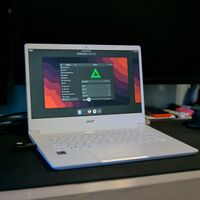Acer Aspire 1 A114-61 (acer-aspire1)
| WARNING: The bootloader chain of the device is located in the same eMMC as the OS, damaging internal partition layout may make the laptop into an unrecoverable brick. See more details below. |
 Aspire 1 running GNOME | |
| Manufacturer | Acer |
|---|---|
| Name | Aspire 1 |
| Codename | acer-aspire1 |
| Released | 2021 |
| Type | laptop |
| Hardware | |
| Chipset | Qualcomm Snapdragon 7c (SC7180) |
| CPU |
2x Kryo 468 Gold 6x Kryo 468 Silver |
| GPU | Adreno 618 |
| Display | 1920x1080 IPS |
| Storage | 64 GB |
| Memory | 4 GB |
| Architecture | aarch64 |
| Software | |
Original software The software and version the device was shipped with. |
Windows 10 |
Extended version The most recent supported version from the manufacturer. |
Windows |
| postmarketOS | |
| Category | testing |
Mainline Instead of a Linux kernel fork, it is possible to run (Close to) Mainline. |
yes |
pmOS kernel The kernel version that runs on the device's port. |
mainline |
Unixbench score Unixbench Whetstone/Dhrystone score. See Unixbench. |
5668.0 |
| Device package |
|
| Kernel package |
|
Internal storage eMMC, SD cards, UFS... |
Works
|
|---|---|
Battery Whether charging and battery level reporting work. |
Works
|
Screen Whether the display works; ideally with sleep mode and brightness control. |
Works
|
Keyboard Whether the built-in physical keyboard works. |
Works
|
Touchpad Whether the built-in touchpad works. |
Works
|
| Multimedia | |
3D Acceleration |
Works
|
Audio Audio playback, microphone, headset and buttons. |
Partial
|
Camera |
Works
|
| Connectivity | |
WiFi |
Works
|
Bluetooth |
Works
|
| Miscellaneous | |
FDE Full disk encryption and unlocking with unl0kr. |
Works
|
USB-A Whether the full-sized USB-A port works. |
Works
|
HDMI/DP Video and audio output with HDMI or DisplayPort. |
Works
|
| Sensors | |
Hall Effect Measures magnetic fields; usually used as a flip cover sensor |
Partial
|
Acer Aspire 1 is a low-end Windows on ARM laptop, based on Snapdragon 7c Gen1, a platform that has great mainline Linux support due to some Chromebooks sharing the same platform.
Variant differences
While the most common version of the device seems to be the "WiFi" variant, an "LTE" version with 8GB ram seem to also exist.
Contributors
- travmurav
Users owning this device
- TravMurav (Notes: wifi, A114-61-S45P, daily use)
Installation
Disabling UEFI Secure-Boot
This device uses the standard UEFI secure-boot. The initial configuration seem to contain the keys for some Linux distributors (i.e. Canonical or Debian) but for now it's probably easiest to just disable it.
Note that the following actions may cause Windows to fail decryption if the Bitlocker was enabled.
- Power on the device and press F2 to enter UEFI setup.
- Go to the Security tab and set the maintenance password. Write it down.
- Go to the Boot tab and disable the Secure Boot. This option is only available if the password is set.
- Go back to the Security tab and remove the password by changing it to the empty string.
Installing pmOS on an external storage
You should be able to perform sdcard installation with some usb-stick as the target. Note that the laptop has no SD slot.
Highly consider making a backup of the internal storage, it seems like the recovery media is not available for this laptop.
Installing pmOS on the internal eMMC
| WARNING: The bootloader chain of the device is located in the same eMMC as the OS, damaging internal partition layout may make the laptop into an unrecoverable brick. |
See Windows on ARM devices page for generic suggestions.
Known Issues
Work-In-Progress Issues
Kernel package in pmOS follows upstream Linux and only contains the changes that were accepted there.
Here are some differences between pmOS and WIP branch:
| Feature | pmOS | WIP | Notes |
|---|---|---|---|
| Hall Effect/Lid sensor | Partial | Partial | The sensor is reported, but can't be used for wakeup yet. |
| Audio | Partial | Partial | Internal mic is not implemented yet. |
Other issues
- The keyboard FN switch in the firmware settings is not effective. By default the media keys will be on top (press Fn to input F1, F2...) and Fn behavior can be swapped via sysfs.
- Using DisplayPort/HDMI audio requires restarting PulseAudio (run
pulseaudio -kafter the cable is plugged for the sound output to be detected. - There may be issues with using PipeWire.